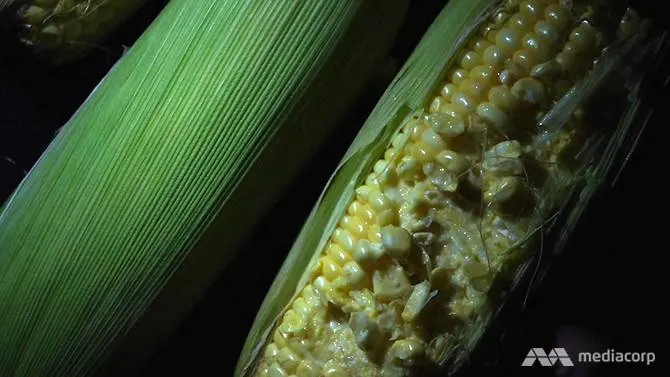How a ‘worm’ might affect prices of cereal, toothpaste and chicken rice
20 October, 2019

It is an insect species almost no one in Singapore has heard of, and it grows to no longer than two inches.
But the fall armyworm is one hungry caterpillar that has devastated cornfields across Asia in a short time, threatening an agricultural disaster.
Corn is found in many things, including animal feed. So a corn shortage could mean higher prices of cereal, toothpaste, chicken and more.
In Thailand, the fall armyworm was first reported last year. And it has since spread to at least 50 of the 77 provinces — nearly two-thirds of the country.
“The pest is so damaging it can eat all stages of the corn.”
To combat this armyworm, his company has deployed hundreds of agricultural experts across Asia, which is responsible for almost a third of the world’s corn supply.
The programme For Food’s Sake! finds out whether there is any way to stop this pest from causing more damage. (Watch the episode here.)
STRONG FLYERS, HUGE APPETITES
This crop devourer is the larvae of the fall armyworm moth. And in three years, it has devoured as much as US$3 billion (S$4.09 billion) worth of crops in Africa.
It got its name because it invades croplands en masse, like an army. And it is moving fast.
Within a year of being spotted in India — in July last year — this armyworm native to the Americas has spread to Sri Lanka, China and many parts of Southeast Asia, such as Malaysia, Indonesia and Thailand.
The adult moths are strong flyers, generally covering more than 400 kilometres in one crop season. “They can fly about 100 km in a single night assisted by winds,” said Dr Gurulingappa. “That’s why they’re able to spread very fast.”
These pests also seem to thrive and reproduce faster in tropical regions, with the high humidity and temperatures. “The adults can lay, on average, around 1,600 eggs,” he added.
“In each of the egg masses, sometimes there’ll be 100 to 200 eggs. So you can imagine how fast the fall armyworm can spread.”
Since it was discovered in Thailand, the country’s leading maize research institute — Kasetsart University’s National Corn and Sorghum Research Centre — has been studying the fall armyworm.
One of the entomologists, Ms Sangkhae Nawanich, said not only can the armyworm cause damage at every stage of the corn, but it also can eat more than 80 varieties of crops, including rice, cabbage and fruits.
In the province of Nakhon Ratchasima, farmer Daeng Phumkokrak grumbled that for the first time in his 40 years of farming, his 40-day-old corn crop may not survive until harvest. Typically, his yield is around 15,000 kilogrammes of corn.
“(The armyworm) eats the crop from the top to the stem,” he said. “It affects about 90 per cent of the crops.”
One corn farmer said he has come across other pests before but never so many that can cause such damage. Another farmer added: “I’ve already used insecticide on some crops, but it isn’t working. I’ve no idea what to do.”
COSTLY IMPLICATIONS
As many of the countries in the region are affected, “that’s immediately causing a supply disruption in corn, so that might increase the price”, pointed out Singapore Management University assistant professor of finance Aurobindo Ghosh.
And with corn being an important source of poultry feed, a dish like chicken rice may end up more expensive as the cost of chicken production goes up in future.
There might be “some substitutes” for corn, but perhaps at a higher cost, said Dr Ghosh. “So the best defence here is to try and prevent the pests from proliferating any more.”
To this end, Corteva Agriscience is teaching farmers how to manage the pest, although “it’s very difficult”, admitted Dr Gurulingappa, because the armyworm burrows deep inside the whorls of leaves and feeds from there.
But there can be more effective control if insecticide is applied the right way to reach the pest, he said.
As a potential solution, the company has also tested seed treatments to protect corn in its early stages, while other experts recommend introducing the armyworm’s natural enemies, such as ants, fungi or even a strain of virus.
For now, because the United States is the world’s top corn producer and exporter — with some soya bean farmers also switching to corn following Chinese tariffs on US soya beans — global supply remains unaffected.
But for how long? As Dr Gurulingappa warned, “The fall armyworm is here to stay (in Asia) and cause significant damage.”
Source:
TAG(s):
